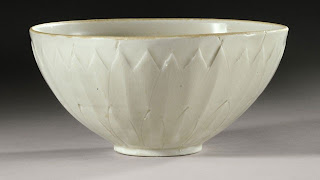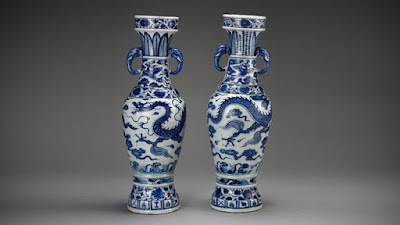Sothebys in New York has reported a bowl sold through the auction house realized 2.2 Million Dollars, which in the world of Asian art is not that unusual. What is unusual the bowl was bought in 2007 for $3 at a yard sale by a family in New York.
 |
Rare Song Dynasty Bowl realizes 2.2 Million Dollars
|
The extremely rare "Ding ware" bowl measuring just 5 inches in diameter and dating to the Song Dynasty sat on the owners mantle as a decoration for the last five years until it was sold in New York. This extremely rare example was bought by London dealer Giuseppe Eskenazi on Tuesday March 19th.
The only other known example was left to The British Museum in 1947 by the legendary collector Henry J Oppenheim.
_____________________________________________________________________
__________________________________________________________________________
Below is the Catalog Entry From Sothebys on the piece.
The finely potted body of slightly rounded and steep flared form rising from a short spreading foot to an upright rim, deftly carved to the interior with scrolling leafy lotus sprays, the exterior carved and molded with three rows of overlapping upright leaves, applied overall with an even ivory-colored glaze with characteristic teardrops at the base, the rim of the bowl and the footrim left unglazed showing the fine compact body beneath. Diameter 5 3/8 in., 13.4 cm - Estimation:
200,000 - 300,000 USD
NOTE: The present bowl displays all the characteristics attributed to the finest ‘Ding’ wares known in museum and private collections. Celebrated for their thin potting, fine near-white body and an ivory-colored glaze which tends to run down in somewhat darker ‘tears’, ‘Ding’ wares were ranked among the ‘five great wares’ of the Song a term coined by collectors of the Ming and Qing dynasties. The high quality of the potting seen here is evident in the feather light weight of the bowl with the carved walls especially thin and delicate. The whiteness of the body is also special, as is the case with most ‘Ding’ wares, it did not require the application of a slip to appear white after firing. The glaze is expertly applied with the incised lotus spray design seen in the interior of the bowl in harmony with the overlapping leaves applied to the exterior of the piece. ‘Ding’ designs generally display a high level of naturalness and fluidity, however, the maker of this bowl appears to have bee particularly skilled at rendering his lines in a spontaneous manner, creating a decoration that is especially free in style. The shape of the bowl is also worth noting as, while rare amongst ‘Ding’ bowls, the type is known from silver examples of the Song period. For example, see a bowl illustrated in Zhongguo jin yin poli falangqi quanji, vol. 2 (2), Shijiazhuang, 2000, pl. 261, together with another silver bowl of more rounded body but the exterior molded with layers of overlapping upright leaves, reminiscent of that seen on this bowl, pl. 262.
Only one other bowl of the same form, size and almost identical decoration is known; the piece in the British Museum London, published in The World’s Great Collections. Oriental Ceramics, vol. 5, Tokyo, 1981, pl. 57. This bowl was bequeathed to the museum in 1947 by Henry J. Oppenheim, together with a small number of other ‘Ding’ pieces, including a plain dish with foliate rim, pl. 62, and a bowl with molded decoration of boys and flowers, pl. 61.
The kiln site identified with ‘Ding’ ware is located at Quyang in Ding county, Hebei province. This was an area formerly known as ‘Dingzhou’. ‘Ding’ production consisted mostly of small utilitarian wares such as dishes and bowls, generally left in their natural form undecorated in 10th and early 11th century. From the late 11th century and early 12th century they are increasingly incised and carved and later through the thirteenth century mold-impressed and densely patterned. Rose Kerr in her work on the collection of Song ceramics in the Victoria and Albert Museum, London, mentions that the ‘fact that Ding ware was an official ware made one feature of its decoration especially pronounced. This was its tendency to mimic other, more precious materials such as gold and silver, huge quantities of which were stored in palace treasures’. See Rose Kerr, Song Ceramics, London, 1982, p. 102, for further information.



$3 Dollar Yard Sale Bowl Brings 2.2 Million At Sotheby'S New York >>>>> Download Now
ReplyDelete>>>>> Download Full
$3 Dollar Yard Sale Bowl Brings 2.2 Million At Sotheby'S New York >>>>> Download LINK
>>>>> Download Now
$3 Dollar Yard Sale Bowl Brings 2.2 Million At Sotheby'S New York >>>>> Download Full
>>>>> Download LINK Z4